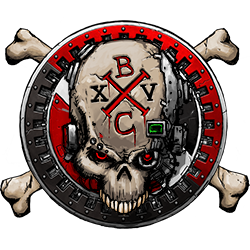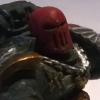Search the Community
Showing results for tags 'The Silver Circle'.
-
*Picture of Space Marines here, still WIP* "A poor hunter chases prey. A good hunter waits for it." - Chapter Master Koganeth, Champions of Athlum, M38.224 Early History: "Some battles are decided before swords are drawn" - Athlumi proverb Amongst the first Chapters created in the 18th Founding, the Champions were given clear objectives from their very inception. Sent to the south-east of the Glastheim Rifts, the Chapter was to establish a base of operations and destroy a festering empire of brutal, lizard-like xeno raiders called the Khovata. Arriving at their designated area of operations, the Champions immediately began a war of calculated aggression, striking the xenos occupiers wherever their defences were weakest and clearing the path for larger Imperial Guard and Navy forces to push the xenos back. On the border of the Kohvate empire lay the Death World of Athlum, a stunningly beautiful but barely hospitable planet filled with hyper-lethal plant and animal life. The Chapter found the planet's climate produced hardy, viable recruits, and quickly adopted Athlum as a homeworld, allowing them to replace the losses incurred during the Khovata wars. The final assault against the Khovata empire saw their homeworld of Lor conquered, the aliens massacred and the scant handfuls of survivors fleeing into distant space. Lor fell into Imperial hands, and was quickly turned into a mining colony to supply the Adeptus Mechanicus with ores and oils. The Champions, having succeeded in breaking the strength of the Khovata, found themselves suddenly beset by Dark Eldar - the Kabal of the Shattered World began launching raids on nearby Imperial worlds, forcing the Champions to chase after this elusive foe. At the same time, Chaos cults began to surface across multiple systems, sometimes in great numbers or with hordes of mutants or daemons in thrall. Beyond this, remnants of the Khovata sometimes launched their own bloody raids from the distant, disparate worlds they had fled to, cutting into the Champions' territory like a scythe, intent on causing as much damage as possible. The Champions were unable to easily pursue foes across so many fronts, and so changed their tactics, drawing inspiration from the hunters on their Homeworld of Athlum. Studying the habits and attack patterns of their enemies, the Champions were able to use smaller forces to lie in ambush, using guile and forward planning to intercept enemy attacks. Chapter serfs were employed as agents, gathering intelligence and acting as watchful eyes for the Chapter on many worlds. When enemies massed in large numbers, the Champions would seldom attack them head-on, instead sending strike teams of a few squads to destroy enemy supplies and materiel, sabotage enemy defences or ships, or assassinate key enemy figures. The Chapter quickly became famous for their "Death of a Thousand cuts" approach to warfare, weakening an enemy to the point the battle was all but decided before the Champions deployed their companies in open war to finish a foe. The Champions of Athlum would, in M37, become part of the "Silver Circle", a band of Chapters around the Glastheim Rifts sworn to defend the Imperium's holdings in that area. Heretics lurking in the Warpstorm-addled Rifts themselves and xeno predators attacking from all angles made the Rifts a dangerous place, but the alliance of Space Marine Chapters worked together - albeit grudgingly - to grant the Imperium some additional purchase in the region. In late M40, the Champions discovered the lost world of Kynasa, that was in many ways a mirror of proud Athlum. Home to a hardy, primitive population dwelling in the forested ruins of ancient Imperial cities, rich in danger for the unwary, and isolated enough to have largely avoided the predations of enemies. Claiming recruitment rights from the world at the same time as claiming Kynasa for the Imperium, the Champions even transported a small but significant portion of Athlum's population to Kynasa to help ensure the world's viability for future generations of recruits. The occupation of Kynasa went smoothly, and the Chapter successfully took it's first batch of recruits from the world before disaster struck, a scant few years later. After feinting an attack at the Maladar system, the Kabal of the Shattered World were able to deploy a large-scale raid on Kynasa, killing or abducting every man, woman and child from the young colony, and retreating back into the webway at blinding speed. The Champions, overcome with grief and rage, raced to get vengeance. In their haste, the Chapter made several errors of judgement that led to an extended series of defeats. Their supply lines were repeatedly targeted by the Drukhari, several Chapter serfs killed or kidnapped while attempting reconnaissance, and on two occasions Company Apothecaries were assassinated in the midst of otherwise unimportant skirmishes with unaffiliated foes. The Champions came to their senses and saw that the Dark Eldar were trying to play them at their own game. The Chapter refocused their anger, turning it from a burning rage into an ice-cold, murderous focus. To this day, both the Kabal and the Chapter remain locked in an endless series of raids, ambushes and gruelling small-scale warfare all across the south-east of the Glastheim Rifts. Recent History: "Our success depends upon our strength. Our strength depends upon our success." - Brother Maliad, Champions of Athlum 7th Company, 516.M41 Amongst the many disasters that befell the Imperium with the opening of the Cicatrix Maledictum, Athlum came under direct attack, thanks to the machinations of the heretical Blades of Atracia. Cults sprang up, seemingly in synchronicity with the appearance of the Cicatrix, no doubt seeded and sheltered by the traitors in the Glastheim Rifts for this very purpose. The Champions were, as always, quick to react, dispersing their forces to be the rock against which this wave of heresy would break. While the Champions were thus occupied, the Blades of Atracia struck at Athlum itself. With half the Chapter still entangled with enemy forces off-world, and less than eighty marines left standing in Athlum's defence, the Champions mounted a desperate last-ditch defence at their Fortress Monastery, gathering as many of the civilians as they could and bunkering down. Before the Blades of Atracia could do much more than breach the second layer of walls, however, reinforcements arrived from an unexpected direction. Companies of Primaris Space Marines, bearing the livery of the Silver Circle's Chapters at the head of innumerable hosts of Adeptus Mechanicus Skitarii and Imperial Guard. The Indomitus Crusade had arrived, and with it came thunderous, inevitable victory for the Champions and the Imperium. The Riftmark leading the Chaos forces was slain, trampled to death by the unyielding Kastelan Robots of Forgeworld Valstrax, causing a mass breakdown of the heretic's command structure. The Champions were much less active in the century following the Battle of Athlum, their efforts focused largely inwards as the Chapter adapted to the changes wrought by both the attack on their own world and the Indomitus Crusade. Eventually, however, the Champions re-emerged from the Battle of Athlum with renewed purpose, striking remorselessly at heretics and aliens wherever they may be found with the Chapter's traditional precision and focus. Recruiting more serfs from other worlds allowed the Champions to spread their intelligence network further while tightening their control on the systems and subsectors around Athlum. Taking steps to ensure Athlum would never be so exposed to enemy action again, a hundred Primaris marines were assigned to what was informally called "The Sentinel Company"; a group dedicated directly to the protection of Athlum itself. Homeworld: "To be entranced by the flower is to forget the presence of the poison." - Athlumi proverb http://www.bolterandchainsword.com/sm.php?b62c=@hXbsb_hOPYE.hmmn0@@@@@@@_@.@@i8khii8khi@@@@@@@@@@@_iakk7_iakk7@@@@@@@@@@hCmX3.@@@@@@@@@@@@@.iakk7&grid=TRUE A Battle Brother of the Champions of Athlum Athlum, the chosen homeworld of the Champions, is a beautiful, verdant paradise, crawling with life. But behind the beautiful visage is a world of extreme danger. Almost every life form on Athlum is dangerous, from the incredibly poisonous blossom trees that turn the forest canopies lilac and pink once a year, to the myriad of insects whose bites can cause permanent damage to unlucky victims. Amongst the deadliest things on Athlum are the carnivorous Wyverns, house-sized flying carnivores that roam the skies looking for exposed targets to feast upon, and the Dirgewolves, giant wolves whose front half is largely covered in scales and bone protrusions, making them very hard to hurt with conventional weapons. The humans of Athlum live in scattered clans, and mostly survive as hunter-gatherers, armed with the finest bows, spears and traps that their craftsmen can make. Only the patient and the skilled can survive on Athlum, and it is from the youth of this hardy caste of hunters that the Champions draw most of their recruits. Known as the Great Spire, the Fortress Monastery of the Champions of Athlum was constructed in the centre of the planet's highest mountain range. The mountains themselves are called "The land of Angels" by the natives, and none dare tread on such sacred ground, leaving the Champions to keep a distant vigil on the people below. The outside of the Spire is faced in gleaming white marble, and it can be seen from almost a week's journey away on the plains below, reaching above even the high peaks. For recruitment trials, the Champions drop would-be aspirants in one of several pre-selected starting points, roughly a day's travel from the base of the mountains, and simply instruct them to reach the Spire. The trial routes bring aspirants face-to-face with some of Athlum's most dangerous wildlife, and then pits survivors against the treacherous, unfamiliar terrain of the mountains as they seek to reach their goal. The Chapter's outlook and methods of war are shaped to a certain degree by the native hunters of Athlum. Patience, planning and decisive action are the keywords by which both hunter and Space Marine live and die. Beliefs: "War is not the only duty of a Champion." - Chaplain Durran, Champions of Athlum 1st Company, 113.M42 Parhaps the most unusual aspect of the Champions of Athlum's outlook on the Imperium is their view on The Emperor. The Champions feel that He looks upon His Imperium with great sorrow, a soul-deep melancholy that what should have been His greatest work was laid to ruin. Additionally, the Champions believe that His Space Marines are the only surviving means of truly uniting and protecting the Imperium, and that The Emperor intended for Space Marines to not only safeguard ordinary humans, but to embody the best aspects of humanity. Thusly, the Champions of Athlum believe the Chapter must excel in all disciplines to be as The Emperor intended them to be. To this end, the Chapter can boast well-practiced craftsmen, diplomats, artists, musicians, and architects as well as great fighters and insightful strategists. The Champions point to their Primarch, Guilliman, and his own multi-faceted talents as further proof that Space Marines should be more than simple fighters. Though this diversity of disciplines obviously serves the Chapter well in many respects, it does come with its own drawbacks. Those who study non-combat disciplines are, inevitably, somewhat less-practiced in war. While the difference is almost imperceptible to outsiders, even fractional hesitations or marginal errors in a combat situation against the enemies of mankind can mean the difference between victory and death. This has led, over the centuries, to something of a culture of preservation in the Chapter, where battle-brothers skilled in one or more non-combat arts are considered to be, informally, of somewhat higher value than their purely war-trained kinsmen. This is done simply to prevent the Chapter's expertise in esoteric disciplines from diminishing, and preserve the reputation of the Chapter as a whole. Furthermore, such is the Champions' conviction that they are closer to The Emperor's ideals for the Space Marine, that many amongst the Chapter tend to treat other Chapters as either short-sighted fools or wilfully ignorant of their true purpose. Thus, the pride of the Champions remains a stumbling block in their relations with other Chapters. The Chapter's diplomatic corps exists, in part, to manage this issue - keeping the more self-assured Champions firmly in line as well as minimizing the risks of conflict between brothers. Battle Doctrines: "Squad Amanir, close with the objective. Squad Uthag, fire on my mark..." - Sergeant Galborn, Champions of Athlum 3rd Company, during the battle of Kryndaia, 233.M41 The Champions of Athlum are somewhat atypical for Space Marine Chapters in that most of their defining victories ultimately come from small-scale actions. Kill Teams sent to eliminate key or isolated enemy figures, or sabotage enemy materiel, or disrupt a foe's supply lines. Combat Patrols using carefully gathered intelligence to cripple an enemy force before it ever truly musters its' strength. Small-scale strikes used to cause large-scale effects, so that when the time comes for the Champions to muster at Company strength and take to the battlefield, often the result of the battle is decided before the Company even deploys for battle. On the battlefield proper, the Champions of Athlum fight as befitting an Ultramarine successor, with fluid battle plans that take advantage of an enemy's weaknesses as they are presented. There is a noted predilection to the use of ambush attacks, outflanking strikes and the use of carefully laid traps, mirroring the methods of hunters on Athlum. The use of camouflage is not only considered acceptable, but encouraged by the Chapter, though their innate pride ensures they seldom completely cover their Chapter's heraldic colours. Organisation: "A leader must set an example. We must set an example." - Codicier Kyrloth, Champions of Athlum 1st Company, 167.M42 Taking pride in the heritage of their Primarch, Roboute Guilliman, the Champions of Athlum proudly adhere to codex-mandated Organisation. Such structure has served the Chapter well in their time in the Glastheim Rifts, being able to disperse or gather to deal with encroaching threats as they rise. For a long time, the only notable deviation was the renaming of the traditional rank of Company or Chapter Champion as "Headtakers", given that each Battle-Brother is already a Champion in name. The arrival of Primaris marines placed the Champions of Athlum in a difficult situation with regards to their Codex-Adherence. Considering themselves exemplars amongst marines, how they handled the issue of the Codex Astartes not making provision for the Primaris Marines was seen in the Chapter as a decision of the utmost importance, and arguments amongst the Champions' leadership for how to handle the issue were commonplace. Eventually, the Primaris marines were all provisionally placed into an Eleventh Company, until such time as a satisfactory decision can be agreed upon by the Champions' leadership. Despite being technically limited to one company, the Primaris marines were scattered to reinforce the existing ten Companies around the Rifts, mirroring the way the First Company veterans are seldom gathered together. A hundred Primaris marines of varying experience and role are kept at Athlum, known within the Chapter as the "Sentinel Company" or "Vigilants" to better ward against another attack at Athlum itself. Marines in the Sentinel Company are rotated back into the regular companies on a yearly basis. Those amongst the Chapter assigned to keep a vigil on specific systems or areas of space where enemy activity is expected are given the honorary title of "Marchwarden", taken from an old Athlumi title. The Title of "High Marchwarden" is bestowed to the marine assigned as the leader of the Sentinel Company. Geneseed: "To excel in all matters is the goal of all right-thinking sons of Guilliman" - Brother Nabirad, Champions of Athlum 2nd Company, 783.M39 The Champions of Athlum bear the genetic lineage of the Ultramarines. Proximity to the radiation of the Glastheim Rifts has caused minor mutations in the Melanchrome, causing the hair of most Champions to transition to bright white from an early age. The Chapter has been known to suffer a lower successful implantation rate for geneseed in new recruits than most Ultramarine successors, but such is the pride of the Champions that they would never deign to simply request more geneseed from any stock but their own. Battlecry: Outside of company-level engagements, the Champions seldom make use of traditional battlecries, however the commonly-used motto "For Athlum and Emperor" seems to double as their most typically-used war call. -=-=-=-=-=-=-=-=-=-=-=-=-=-=-=-=-=-=-=-=-=-=-=-=-=-=-=-=-= Updated: 13/7/2021 Quotes! Also added and refined some more stuff, addressing more points raised by my erstwhile and vigilant Brothers. Specific relations with the rest of the Silver Circle will have to wait until I've actually defined the rest of the Silver Circle. Updated further, trimmed a few words. It hasn't made much difference to the size of the article but I suppose every little helps!
- 23 replies
-
- Ace Debonair
- The Silver Circle
- (and 4 more)


